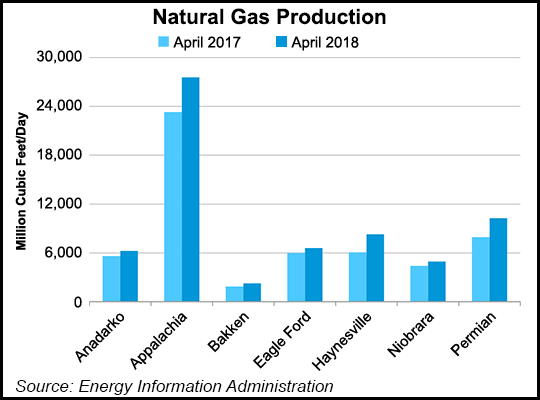E&P | NGI All News Access | NGI The Weekly Gas Market Report
Oil, Gas Production in Big Seven Plays to March Ever Higher in April, Says EIA
The upward trend of oil and natural gas production out of the nation’s seven most prolific onshore unconventional plays, which began more than a year ago, is likely to continue in April compared with March, according to the Energy Information Administration (EIA).

None of the Big Seven plays — the Anadarko, Appalachian and Permian basins, and the Bakken, Eagle Ford, Haynesville and Niobrara formations — are expected to see month/month production declines in April, according to EIA’s latest Drilling Productivity Report (DPR), which was released Monday. That would continue a trend that has been underway since January 2017.
The DPR uses recent data on the total number of drilling rigs in operation along with estimates of drilling productivity and estimated changes in output from existing wells to provide estimated changes in production for the seven key regions.
Total oil production in the seven plays is expected to increase to an estimated 6.95 million b/d in April, compared to 6.82 million b/d in March, an increase of about 131,000 b/d, EIA said.
Most of the increase in oil production is to come from the Permian, which is forecast to reach 3.16 million b/d, compared to 3.08 million b/d in March.
Lesser increases are expected in five other plays, with the Anadarko estimated at 493,000 b/d, Appalachia at 115,000 b/d, Bakken at 1.22 million b/d, Eagle Ford at 1.33 million b/d, and Niobrara at 595,000 b/d. The Haynesville (42,000 b/d) is forecast to see oil production remain unchanged month/month.
Total natural gas production from the plays is expected to reach 66.12 Bcf/d in April, compared to 65.15 Bcf/d in March, with increases expected from all seven plays. The Appalachian Basin, home to the mighty Marcellus and Utica shales, will lead the way with an estimated 27.56 Bcf/d, compared to 27.20 Bcf/d in March, EIA said.
Increases are also expected in the Anadarko (6.24 Bcf/d from 6.23 Bcf/d), Bakken (2.25 Bcf/d from 2.22 Bcf/d), Eagle Ford (6.59 Bcf/d from 6.52 Bcf/d), Haynesville (8.29 Bcf/d from 8.10 Bcf/d), Niobrara (4.94 Bcf/d from 4.87 Bcf/d) and Permian (10.25 Bcf/d from 10.02 Bcf/d).
Drilled but uncompleted (DUC) well counts across the Big Seven ended February at 7,601, an increase of 110 from January, EIA said.
The bulk of those DUCs were in the Permian, which saw an increase of 122 in February to 2,937, and in the Eagle Ford, which increased 30 to 1,492. Four of the Big Seven plays saw their DUC numbers decrease from January: the Appalachian (minus 19), the Bakken (minus four), the Haynesville (minus five) and the Niobrara (minus 16).
The productivity of new oil wells in the plays is expected to increase in April to 673 b/d, according to the DPR. New-well gas production per rig is also expected to increase during the month, to 3.77 MMcf/d.
© 2024 Natural Gas Intelligence. All rights reserved.
ISSN © 2577-9877 | ISSN © 1532-1266 | ISSN © 2158-8023 |
